September 2017 LIP of the Month
The Early Permian Panjal Traps
- Gregory Shellnutta
aNational Taiwan Normal University, Department of Earth Sciences, 88 Tingzhou Road Section 4, Taipei 11677, Taiwan
E-mail address: jgshelln@ntnu.edu.tw
Extracted and modified after: Shellnutt, J.G. 2017. The Panjal Traps. In: Sensarma, S., and Storey, B.R. (eds.), Large Igneous Provinces from Gondwana and Adjacent Regions. Geological Society of London Special Publications 463, doi.org/10.1144/SP463.4.
Introduction
The Permian Himalayan Magmatic Province (HMP) is an assortment of volcanic and plutonic sequences and mafic dykes that are broadly contemporaneous with the rifting of terranes from the Tethyan margin of Gondwana (Bhat et al., 1981; Honegger et al., 1982; Bhat, 1984; Papritz & Rey, 1989; Garzanti et al., 1999; Ernst & Buchan, 2001; Yan et al., 2005; Zhu et al., 2010; Shellnutt et al., 2014; Zhai et al., 2013; Wang et al., 2014; Xu et al., 2016). The volcanic sequences of the central and eastern Himalaya such as the Abor, Nar-Tsum, Bhote Kosi, Selong and Mojiang volcanic groups and Qiangtang mafic dykes are amongst the many occurrences of basaltic rocks that are considered to be related to the formation of the Neotethys Ocean and the ribbon-like continent Cimmeria but the Panjal Traps located in the western Himalaya of India and Pakistan is the single largest outcropping volcanic rocks of the HMP (Sengor, 1987; Bhat et al., 1981; Bhat, 1984; Yan et al., 2005; Chauvet et al., 2008; Zhu et al., 2010; Shellnutt et al., 2011, 2014, 2015; Ali et al., 2012; Zhai et al., 2013; Wang et al., 2014). Moreover, there are a number of plutonic rocks in Pakistan that are coeval with the eruption of the Panjal Traps. The exact petrogenetic relationship between the Early Permian magmatic rocks of the HMP is poorly constrained and it is possible that the HMP is no more than a collection of mutually exclusive disjointed units that were emplaced within the same regional-scale tensional regime along the Tethyan margin of Gondwana during the first 30 million years of the Permian. The eruption of the Panjal Traps and associated plutonic rocks has significant importance for unraveling pre-India-Eurasia collision tectonics of Gondwana. Consequently, constraining the petrogenesis of the Panjal Traps can help address issues such as the geodynamic and tectonomagmatic evolution of the Late Permian Tethyan margin of Gondwana as well as offer insight into the formation of LIPs with specific relevance to the ‘plate hypothesis’ (passive extension) vs. ‘mantle plume theory’ (active extension) of LIP formation (e.g. Ernst, 2014).
Geological background
The Panjal Traps cover an area of ~10 000 km2 exposed primarily around the Kashmir Valley along the Pir Panjal and Zanskar Ranges (Fig. 1). The Traps are mostly basalt but there are volumetrically minor flows of basaltic andesite, andesite, rhyolite and dacite (Ganju, 1944; Nakazawa & Kapoor, 1973; Pareek, 1976; Bhat et al., 1981; Shellnutt et al., 2012, 2014). The Traps show evidence of subaerial (columnar joints) and subaqueous (pillow structures) eruptive environments that Nakazawa & Kapoor (1973) interpreted as indicative of a near-shore, transgressive shallow marine environment (Fig. 2). Intertrappean limestones, shales and slates are reported near Gulmarg and Bren (Pir Panjal Range) suggesting there were intermittent pauses during volcanism. The reported total thickness of the volcanic rocks in the Pir Panjal Range (western Kashmir) is ~3000 m whereas in the Zanskar Range (eastern Kashmir) it is £ 300 m (Nakazawa & Kapoor, 1973; Nakazawa et al., 1975; Chauvet et al., 2008; Wopfner & Jin, 2009). Typically, individual flow units within the volcanic pile are ~30 m thick. The volcanic centre of the Panjal Traps is inferred to be located in western Kashmir (Kashmir Valley) because the total flow thickness (~3 km) is the greatest in that region (Nakazawa & Kapoor, 1973). Permian komatiitic and basaltic rocks from Chhongtash in northern Ladakh are tentatively correlated with the Panjal Traps (Rao & Rai, 2007).
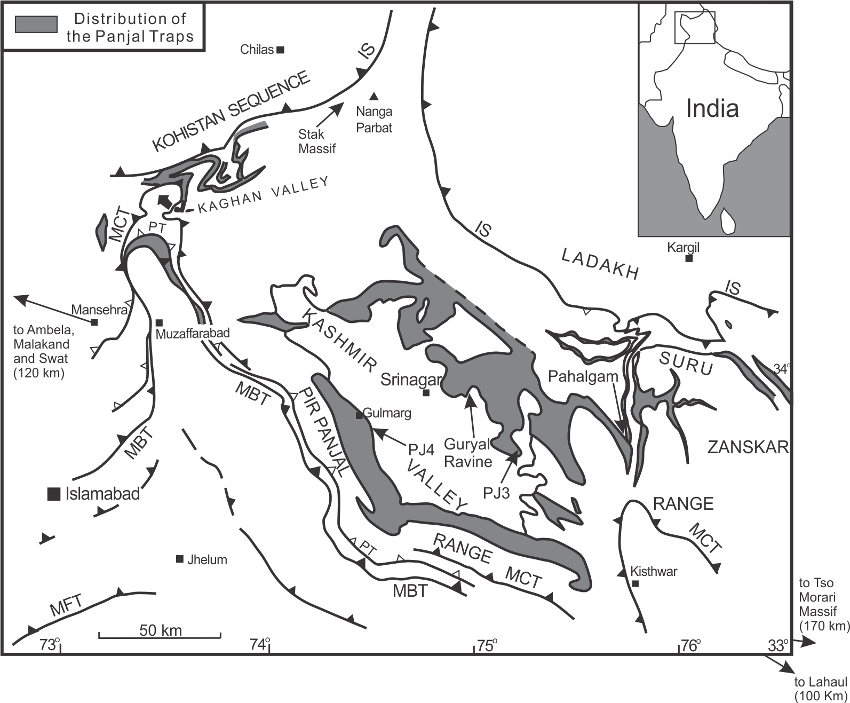
Fig. 1. Distribution of the Panjal Traps and major faults of the western Himalaya (based on Papritz & Rey, 1989). IS = Indus suture; MBT = main boundary thrust; MCT = main central thrust; MFT = Salt Range main frontal thrust; PT = Panjal thrust.
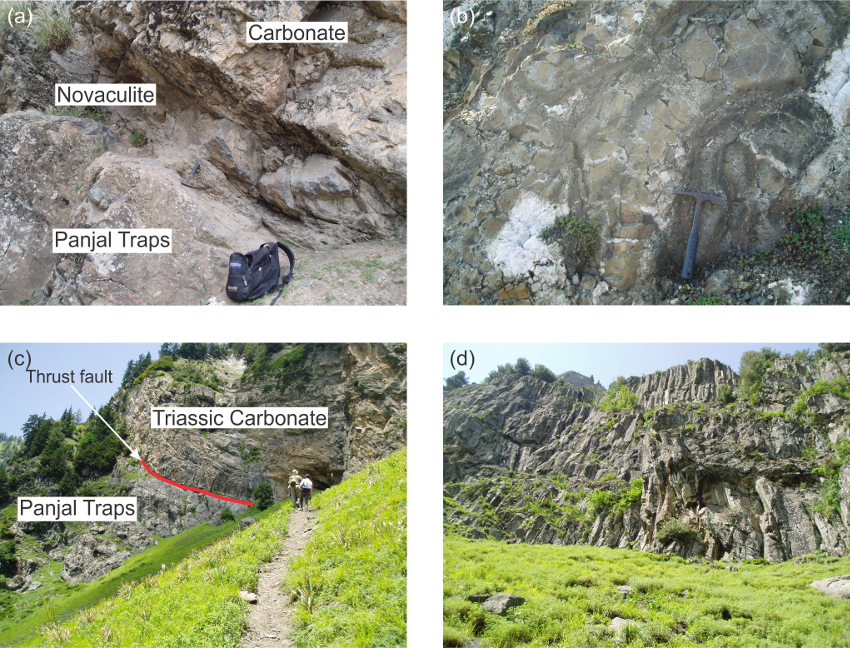
Fig. 2. Field photographs of the Panjal Traps showing (a) contact between novaculite and the uppermost basalts at Guryal Ravine, (b) pillow basalt (near Awantipora), (c) tectonic contact with Triassic carbonates (near Chandanwadi) (d) relict columnar joint structures near Chandanwadi.
Age and duration of volcanism
Middlemiss (1910), based on the presence of ammonites from the genus Ophiceras in overlying sediments, interpreted the age of the Panjal Traps as Upper Palæozoic. Subsequent detailed structural and sedimentological studies by Nakazawa et al. (1975) and Kapoor (1977) showed that the lava erupted after the deposition of the Late to Middle Carboniferous Fenestella shale and before the deposition of the Gangamopteris beds. The first radioisotopic age of the Panjal Traps was analyzed from zircons collected from the silicic Traps near Srinagar (Shellnutt et al., 2011). The in situ zircon LA-ICP-MS U/Pb dating from a rhyolite near Srinagar yielded a weighted mean 206Pb/238U age of 289 ± 3 Ma and is consistent with the geological interpretations of Nakazawa et al. (1975). The age definitively demonstrates that the Traps erupted during the Early Permian. At the moment, very few definitive statements can be made regarding the duration of Panjal magmatism but it is clear that it was underway by the Early Permian. The initial volcanic rocks are considered to be the Agglomerate slate which is interpreted to be an ‘explosive volcanic’ unit and consists of ash and possibly volcanic bombs although non-volcanic fossiliferous material appears to predominate (Nakazawa & Kapoor, 1973; Nakazawa et al., 1975). The Agglomerate slate is followed by the main effusive sequence. Gaetani et al. (1990) suggests the eruption duration was 2 to 3 Ma based on faunal markers from NW Lahul-SE Zanskar but the volcanic sequences are thinner than those around the Kashmir Valley and may be incomplete. The basalts at Guryal Ravine are capped by sedimentary rocks (novaculite and carbonate rocks) that are Early Permian (Artinskian) in age but that does not preclude the possibility that magmatism continued after the deposition of the Gangamopteris beds and Zewan formation (Fig. 3) (Nakazawa et al., 1975; Wopfner & Jin, 2009). It is possible that volcanism ended at different times in different localities and that the preserved ‘continental’ portion of the Panjal Traps is strictly Early to Middle Permian but as the rift developed into an ocean basin, and later the Neotethys Ocean, volcanism became strictly ‘oceanic’ in nature (Shellnutt et al., 2015).
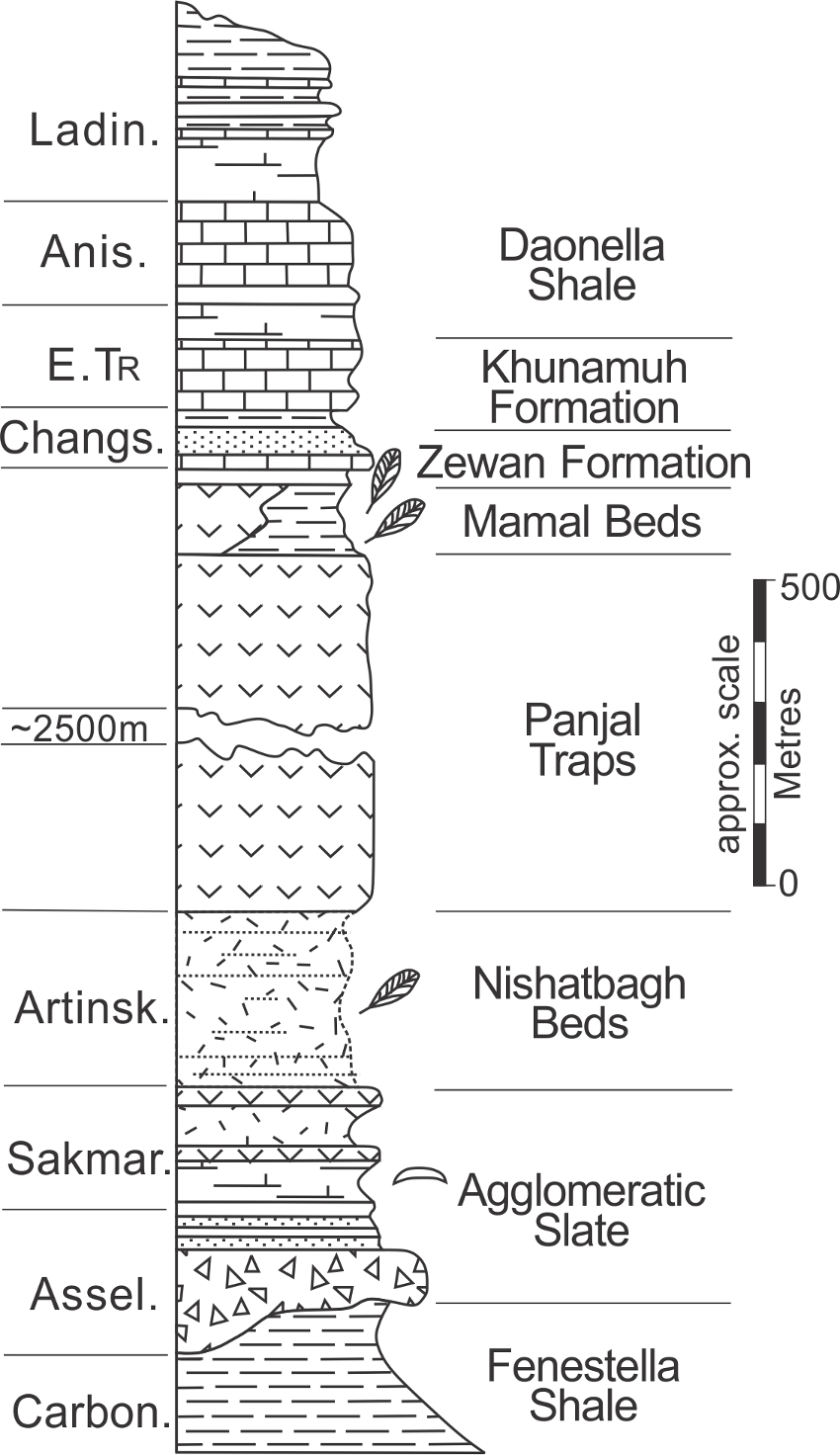
Fig. 3. Generalized Late Palæozoic stratigraphy of the Pangæa Megasequence of Kashmir from Wopfner & Jin (2009). Carbon. = Carboniferous; Assel. = Asselian; Sakmar. = Sakmarian; Artinsk. = Artinskian. Changs. = Changhsingian; ETR. = Early Triassic; Anis. = Anisian; Ladin. = Landinian.
Mafic Panjal Traps
Chemical characterization
Most of the Panjal Traps chemically classify as ‘within-plate basalt’, were probably derived from a relatively reducing mantle source (FMQ -1), and have light rare earth element enriched (La/YbN » 4; Sun & McDonough, 1989) chondrite normalized patterns (Figs. 4-6). However, there are some rocks that are compositionally similar to ocean-floor basalt and have REE (La/YbN < 2; Sun & McDonough, 1989) patterns similar to enriched mid-ocean ridge basalts (E-MORB). Some thick volcanic sequences around the Kashmir Valley show chemostratigraphic variations, specifically with respect to the TiO2 concentration, as there appears to be groups of high-Ti (TiO2 > 1.7 wt%) and low-Ti (TiO2 < 1.7 wt%) basalts. There is distinct TiO2 variability within specific sequences but considering all basaltic data there is a continuous spectrum of compositions (Fig. 7a). In broad terms the Mg# and the Ti/Y ratio offer better discrimination of the basalts as there appears to be three groups: 1) high Mg# group (>57), 2) middle Mg# group (50 to 57) and 3) low Mg# group (< 50). In combination with the Ti/Y ratio, it seems that samples with Ti/Y < 350 have the highest Mg# (Figs. 7b, c & d). Furthermore, the rocks with the highest Mg# values are likely closer to their ‘primary’ compositions as they tend to have higher Ni (> 100 ppm) content than the rocks with lower Mg# values (Ni < 100 ppm). Within specific basalt sequences the application of a Ti-based classification scheme is useful but its broad application to the Panjal Traps is somewhat cumbersome.
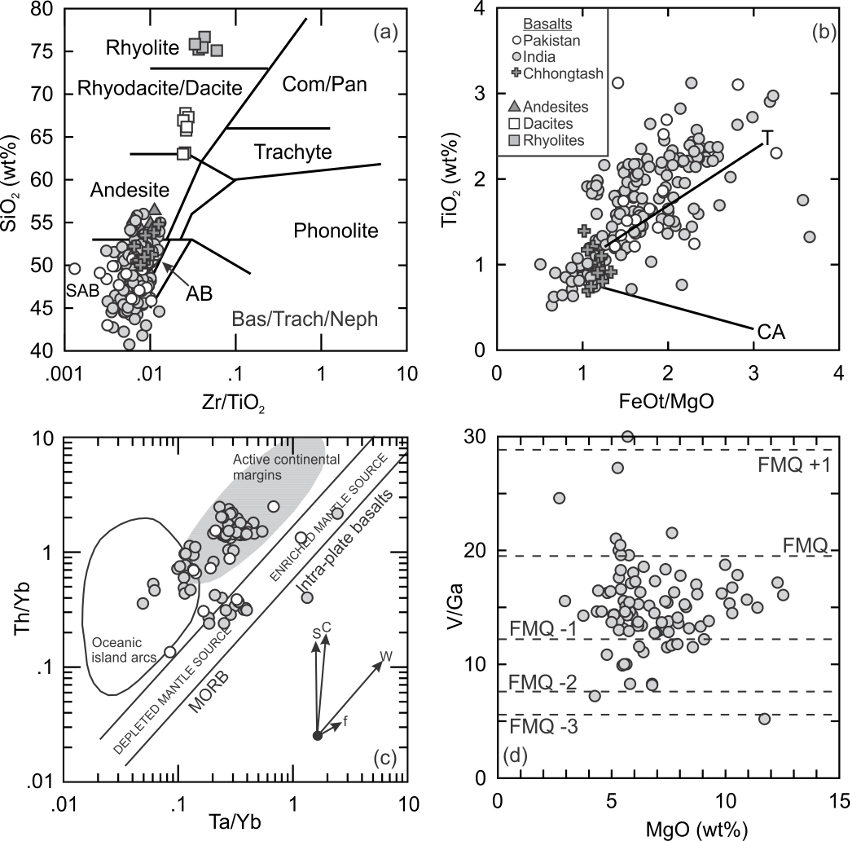
Fig. 4. (a) Rock classification of the Panjal Traps using immobile elements (Winchester & Floyd, 1977). SAB = sub-alkaline basalts, AB = alkaline basalt, Com/Pan = Comendite/Pantellerite, Bas/Trach/Neph = basanite, trachybasanite nephelinite. (b) Discrimination of the tholeiitic (T) basalts from the calc-alkaline (CA) basaltic rocks (Miyashiro, 1974). (c) Th/Yb vs. Ta/Yb basalt discrimination diagram of Wilson (1989) showing the differences between seduction and oceanic basalts derived from depleted and enriched source. Vectors show influence of each component, S = subduction component, C = crustal component, W = within plate enrichment, f = fractional crystallization. (d) Binary diagram showing the use of bulk-rock V/Ga to indicate the redox condition of the mafic Panjal Traps. Reference lines at various fO2 are after Mallmann & O'Neill (2009). Data from Pareek (1976), Bhat et al. (1981), Bhat & Zainuddin (1978, 1979), Honegger et al. (1982), Papritz & Rey (1989), Pogue et al. (1992), Vannay & Spring (1993), Rao & Rai (2007), Chauvet et al. (2008) and Shellnutt et al. (2012, 2014, 2015).
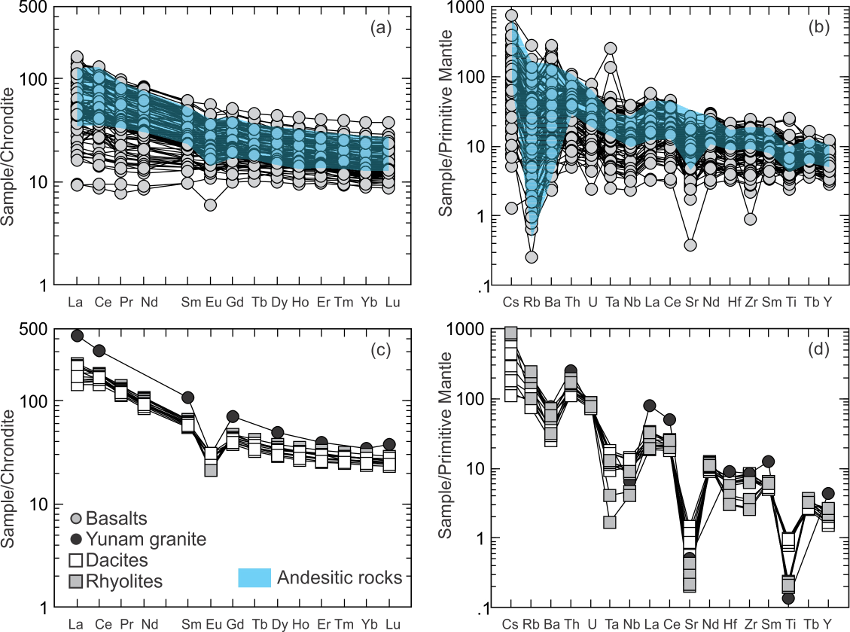
Fig. 5. (a) Chondrite normalized rare-earth element and (b) primitive mantle normalized incompatible element plots of the plots of the mafic and andesitic rocks of the Panjal Traps. (c) Chondrite normalized rare-earth element and (d) primitive mantle normalized incompatible element plots of the plots of the silicic volcanic and plutonic rocks of the Panjal Traps. Normalizing values of Sun & McDonough (1989). Data from Pogue et al. (1992), Spring et al. (1993), Rao & Rai (2007), Chauvet et al. (2008) and Shellnutt et al. (2012, 2014, 2015).
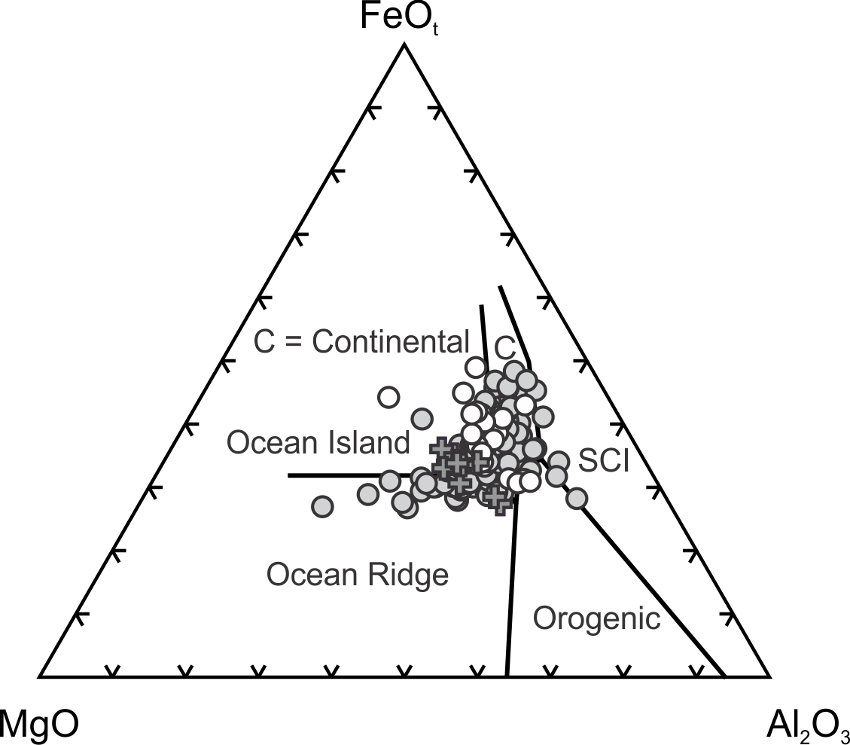
Fig. 6. Basalt tectonomagmatic discrimination diagram of Pearce et al. (1977) for the mafic Panjal Traps. C = continental basalts, SCI = spreading centre island (e.g. Iceland, Galapagos). Symbols as in figure 2. Data from Pareek (1976), Bhat et al. (1981), Bhat & Zainuddin (1978, 1979), Honegger et al. (1982), Papritz & Rey (1989), Pogue et al. (1992), Vannay & Spring (1993), Rao & Rai (2007), Chauvet et al., (2008) and Shellnutt et al. (2012, 2014, 2015).
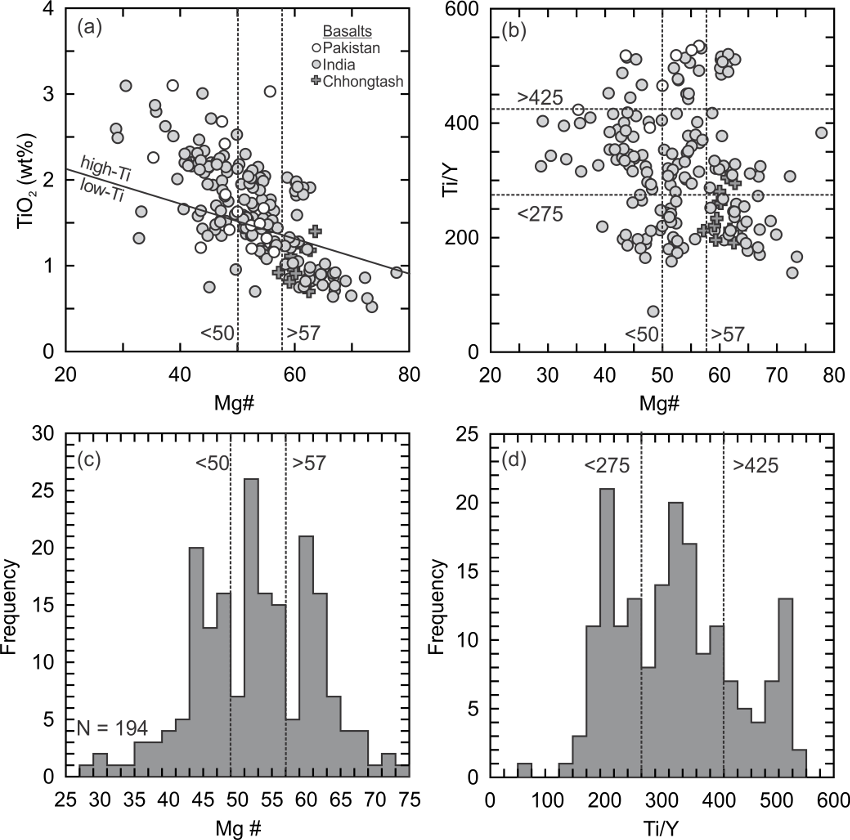
Fig. 7. Ti-classification of the Panjal Traps. (a) TiO2 (wt%) vs. Mg# (based on Lightfoot et al. 1993). (b) Ti/Y vs. Mg#. (c) Histogram of the Mg# of the basaltic Panjal Traps. (d) Histogram of the Ti/Y of the basaltic Panjal Traps. Data from Pareek (1976), Bhat et al. (1981), Bhat & Zainuddin (1978, 1979), Honegger et al. (1982), Papritz & Rey (1989), Pogue et al. (1992), Vannay & Spring (1993), Rao & Rai (2007), Chauvet et al. (2008), and Shellnutt et al. (2014, 2015).
There are only a few studies that report the Sr-Nd isotopes of the Panjal Traps (Spencer et al., 1995; Chauvet et al., 2008; Shellnutt et al., 2014, 2015). The Sr isotopes are quite variable (87Sr/86Sri = 0.7043 to 0.7185) which may, at least partially, be due to Rb or Sr mobility during greenschist facies metamorphism (Fig. 8). The basalts with the lowest 87Sr/86Sri values are probably closer to their unmodified initial values as they are less altered (87Sr/86Sri = 0.7043 to 0.7073). The Nd isotopes are also variable (eNd(t) = -6.1 to +4.3) but Sm and Nd are less susceptible to mobility and are probably indicative of their magmatic value. There are six samples reported by Shellnutt et al. (2014) that may reflect the initial, uncontaminated basaltic magmas as they have eNd(t) values between -1.4 and +1.3, 87Sr/86Sri values between 0.7043 and 0.7073 and do not have high Th/NbPM (> 3) ratios or low Nb/U (< 20) ratios. The remaining rocks, including the rocks with the highest eNd(t) values, appear to have been affected by crustal contamination.
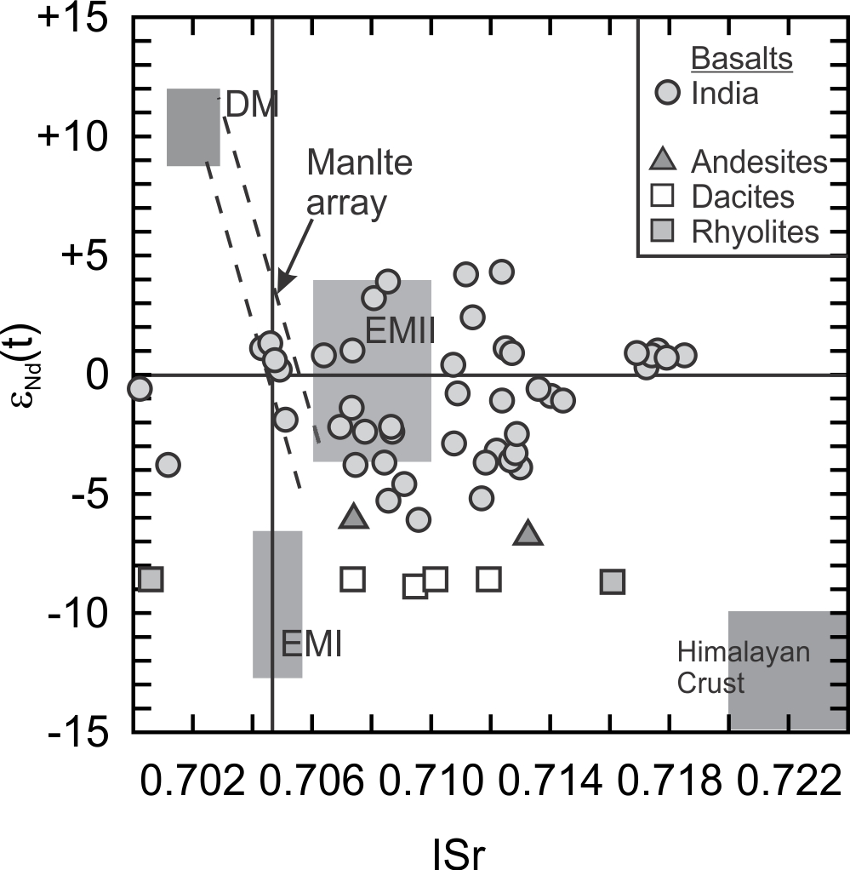
Fig. 8. Sr-Nd plot showing the mafic and silicic Panjal traps from the Kashmir Valley region. BA = basaltic andesite, DM = deplete mantle, EMI = enriched mantle I, EMII = enriched mantle II (Zindler & Hart, 1986; Workman et al., 2004; Workman & Hart, 2005). Isotopic range of the Himalayan crust from Spencer et al. (1995). Data from Chauvet et al. (2008) and Shellnutt et al. (2012, 2014, 2015).
Magma differentiation and crustal contamination
Most of the Panjal Traps have experienced to varying degrees either crystal fractionation or crustal contamination, or both, and therefore, do not represent primary magma compositions. Shellnutt et al. (2014, 2015) suggest that the ‘high-Ti’ rocks from Pahalgam and some rocks from the Pir Panjal (‘low-Ti’) Range experienced crystal fractionation. The ‘high-Ti’ rocks likely experienced olivine and plagioclase fractionation whereas the ‘low-Ti’ rocks likely experienced clinopyroxene and olivine fractionation. However, many rocks do not demonstrate clear geochemical evidence of fractional crystallization and may represent a close approximation of their original eruptive composition.
The range of trace element ratios (Nb/La, Th/Yb, Ta/Yb and Nb/U) sensitive to crustal contamination and the initial Nd isotopes suggests many basalts experienced crustal contamination (Campbell, 2002; Rudnick & Gao, 2003). The Nb/La values of the Panjal Traps are generally < 1.0 although a few samples have higher values whereas the Nb/U (6 to 102) and Th/NbPM (0.5 to 6.9) ratios have a wide range of values (Fig. 9). Isotopic modeling using an enriched end-member similar to Himalayan crust and the least contaminated Panjal Traps indicates that the amount of crustal contamination is typically between 5% and 10% for specific units from the Guryal Ravine and Pahalgam sections but there are some exceptions and larger amounts (> 20%) of contamination likely occurred and produced the andesitic rocks (Shellnutt et al., 2014, 2015).
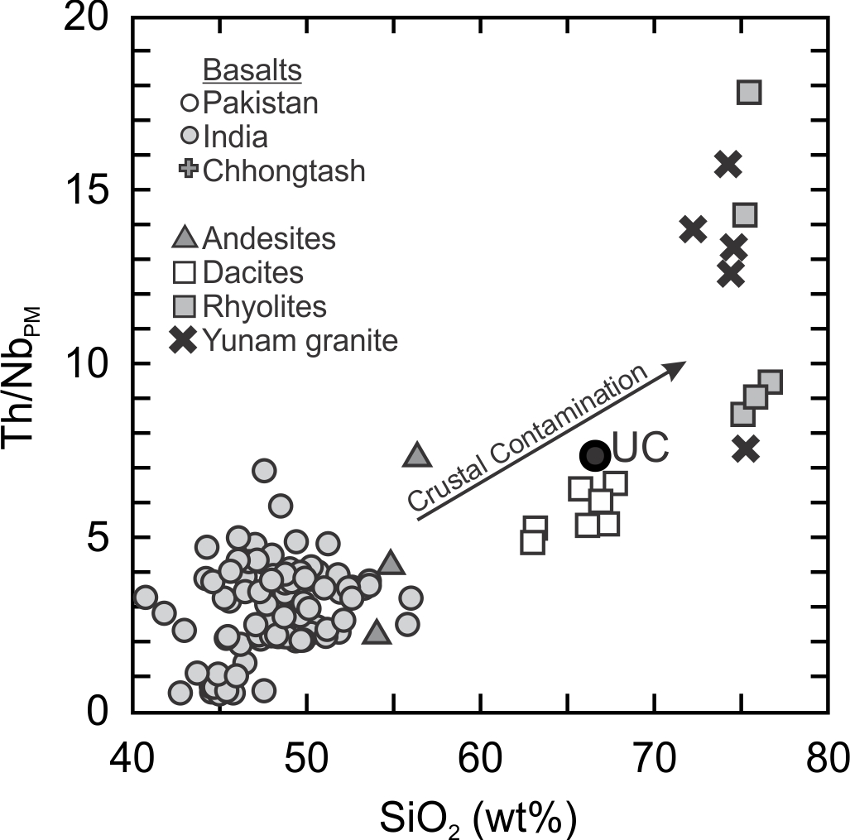
Fig. 9. Th/NbPM vs. SiO2 (wt%) of the Panjal mafic, intermediate and silicic rocks. The trend toward higher Th/NbPM and SiO2 within the basaltic rocks is likely due to crustal contamination. UC = upper crust values from Rudnick & Gao (2003). Data from Spring et al. (1993), Chauvet et al. (2008) and Shellnutt et al. (2012, 2014, 2015).
Primary magma composition
The primary melt composition of basalt can be deduced from its bulk composition providing it has only experienced olivine loss because the adiabatic temperature-pressure melting path is very similar to the olivine liquidus. The software PRIMELT3 was used to estimate the mantle potential temperature and the primary composition of the Panjal mafic rocks. Only two ‘low-Ti’ basalts from the Kashmir Valley produce internally consistent results. The calculations suggest the primary magmas were picritic and experienced ~10% to ~20% olivine loss. The accumulated fraction melt (AFM) eruptive temperatures (T) and mantle potential temperatures (TP) are estimated to be < 1340oC and < 1450oC respectively. The results suggest that thermal regime was not anomalously hot, as the estimates are closer to ambient mantle (1300oC to 1400oC) rather a mantle plume regime (³1550oC).
Mantle source
The mantle source of the Panjal Traps was very likely a spinel peridotite (Shellnutt et al., 2014, 2015). The low Nb/Y (≤ 0.5) and Zr/Y (≤ 4.6) ratios of the Panjal Traps are more similar to basalts derived from a spinel-peridotite source than from a garnet-peridotite source (Fitton et al., 1997; Baksi, 2001). Trace element modeling suggests that low to moderate degrees of partial melting of a source, assuming a spinel lherzolite primitive mantle starting composition, can reproduce the range of the REE patterns seen in the Panjal rocks. The basalts from Guryal Ravine and Pahalgam that do not show clear evidence for crustal assimilation can be modeled by 3% to 7% batch melting of a spinel lherzolite (olivine = 57%, orthopyroxene = 26, clinopyroxene = 15%, spinel = 2%) (Fig. 10). Samples with relatively flat REE patterns can be modeled with >10% partial melting.
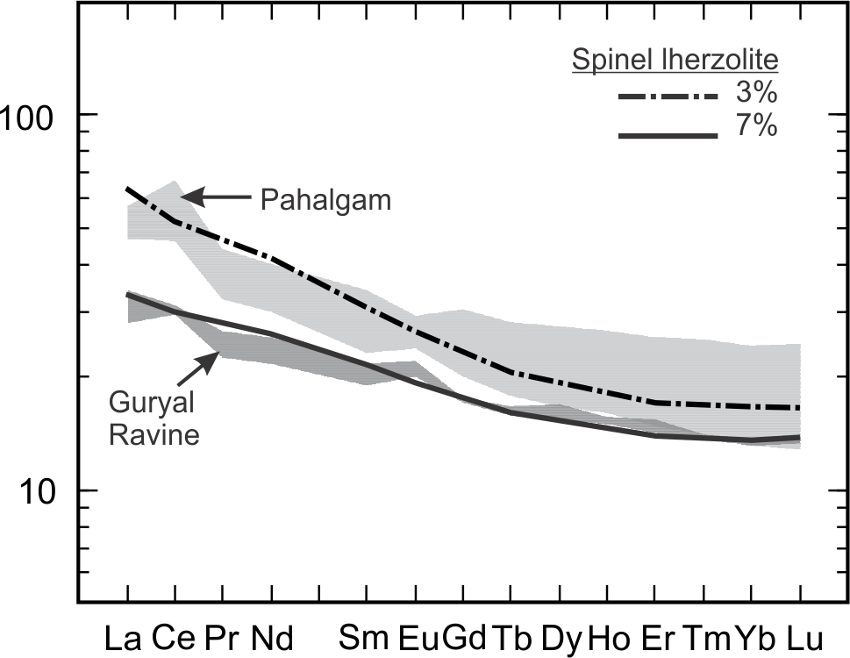
Fig. 10. Results of rare earth element modeling with respect to the least contaminated Panjal Traps from Guryal Ravine and Pahalgam. The models assume a primitive mantle starting composition (Sun & McDonough, 1989). The composition of the spinel lherzolite is: olivine = 57%, orthopyroxene = 26, clinopyroxene = 15, spinel = 2%. Batch melting equation: CL/Co = 1/D(1-F)+F, CL = concentration in the liquid, Co = original rock composition, D = bulk distribution coefficient, F = weight fraction of melt produced. The detail of modeling can be found in Shellnutt (2017).
It is likely that the Panjal Traps were derived from two isotopically distinct mantle sources, one similar to chondritic mantle (subcontinental lithospheric mantle) and another that was similar to asthenospheric mantle. Figure 11 shows three regression lines (Guryal Ravine line, Pahalgam line and PJ4 line) of the Panjal Traps using eNd(t) and the Th/NbPM ratio. The Th/NbPM ratio is an indicator for crustal contamination where average upper crust (UC) has a value of 7.3, depleted MORB mantle (DMM) has a value of 0.45 and primitive mantle (PM) is 1.1. Therefore the ‘uncontaminated’ Traps should be closer to either the DMM or PM values and the contaminated rocks should be between either DMM or PM and UC. It is clear that only a small cluster of samples have chondritic eNd(t) values (eNd(t) = 0 ± 1) with low Th/NbPM values (0.5 to 1.0). The uncontaminated samples can form two separate ‘mixing lines’, one with basalts from Guryal Ravine whereas the other is with basalts from Pahalgam. When the ‘mixing lines’ are extended to higher Th/NbPM values they passed through or very close to either the Panjal dacites (Guryal Ravine line) or the Panjal rhyolites (Pahalgam line) suggesting specific silicic volcanic rocks may have acted as the enriched end-member that contaminated specific basaltic sections (Fig. 11). A third ‘mixing’ line (PJ4 line) is observed involving rocks collected from the Pir Panjal Range near Gulmarg (PJ4 sampling site in Shellnutt et al., 2015). The PJ4 line when extended to higher Th/NbPM values passes through the basalt data reported by Chauvet et al. (2008) from the Zanskar Valley and crosses between the dacites and rhyolites. If the PJ4 regression line is extended to intercept either the DMM or PM line then the corresponding eNd(t) value is between +8 and +9 and similar to depleted mantle. The samples that fall along the upper trend-line appear to favour a contaminant similar to the Panjal silicic rocks. Thus, it is possible that the original mantle source that produced the uncontaminated chondritic basalts was the SCLM whereas basalts from the Pir Panjal Range and some of those reported by Chauvet et al. (2008) were derived from a source that had greater influenced of asthenospheric mantle.
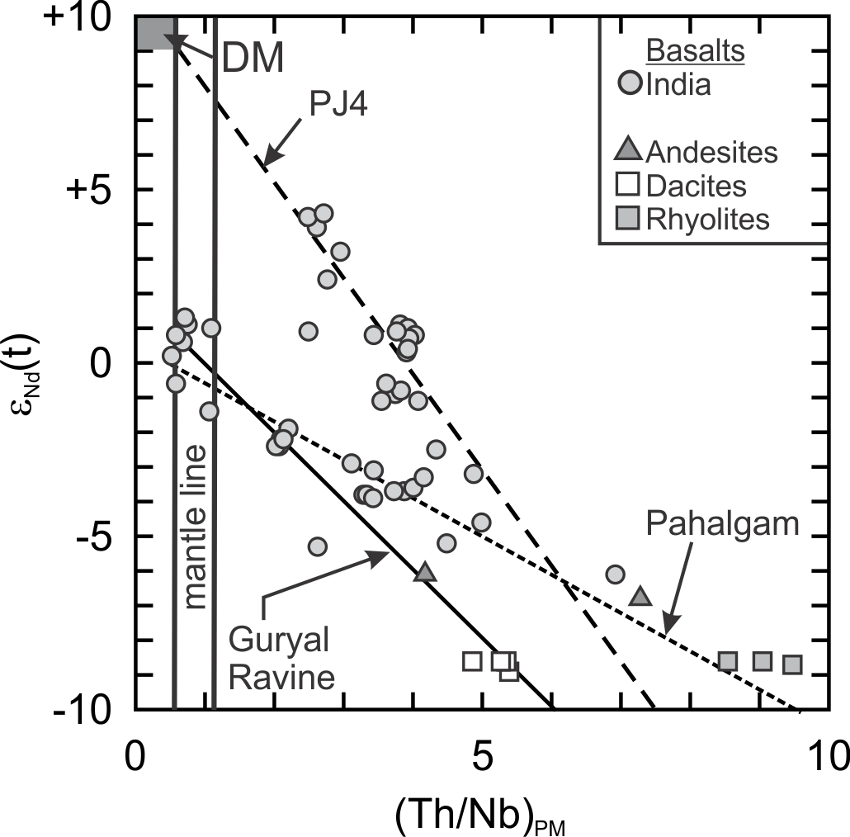
Fig. 11. eNd(t) vs. Th/NbPM showing three mixing lines of the Panjal basaltic rocks and silicic rocks calculated by Shellnutt et al. (2015). Total mafic Panjal Traps data are superimposed on the calculated mixing lines. The mantle line is based on depleted MORB mantle of Workman & Hart (2005). The calculated regression lines for the basalt data are extended to the x-axis and the mantle line. Th/NbPM is normalized to primitive mantle values of Sun & McDonough (1989). DM = depleted mantle of Workman & Hart (2005). Data from Chauvet et al. (2008) and Shellnutt et al. (2012, 2014, 2015).
Andesitic Panjal Traps
The main volcanic sequences around the Kashmir Valley have horizons of andesitic rocks. Andesitic rocks are reported from Guryal Ravine, Pir Panjal and the Liddar Valley near Pahalgam (Bhat & Zainuddin, 1978; Shellnutt et al., 2014, 2015). The whole rock compositions are typically basaltic andesite as they have SiO2 contents between 54 wt% and 56 wt%. The Panjal andesitic rocks are compositionally transitional between the mafic and silicic rocks and are probably derived by mingling between mafic magmas and crustal melts. The whole rock Sr-Nd isotopes (eNd(t) = -6.8 to -6.1) are more enriched than the basalts but less than the silicic rocks (Fig. 11). Moreover Th/NbPM (2.0 to 6.8) values and Nb/U (5.2 to 22.1) values are also between the silicic and basaltic rocks (Figs. 9 & 11). Isotopic and trace element modeling suggests that between 20% and 30% mingling of a dacite or rhyolite and basalt could produce the compositions similar to the andesitic rocks (Shellnutt et al., 2014). However, the type of contaminant will have a great effect on whether the bulk SiO2 and TiO2 are above or below 55 wt% and 1 wt% respectively. As mentioned earlier, it seems that a specific contaminant (rhyolite or dacite) can be identified within some volcanic sequences (Fig. 11).
Silicic Panjal Traps
The Panjal Traps have a volumetrically minor but petrologically significant portion of dacite and rhyolite that appear to be restricted to the eastern part of the Kashmir Valley (Ganju, 1944; Pareek, 1976; Shellnutt et al., 2012). Thus far silicic volcanic rocks have not been reported in the Zanskar, Lahul or Liddar valleys. Early investigations suggested they were derived by differentiation of mafic Panjal magmas but more recently studies indicate they are likely to be crustal melts (Shellnutt et al., 2012). The whole rock chemistry shows the rocks are peraluminous, calcic to calc-alkalic and have enriched isotopic compositions (eNd(t) = -8.6 to -8.9) that are more similar to average Himalayan crust (eNd(t) = -10 to -14) than to the mafic Panjal rocks (Fig. 8). Furthermore, the silicic rocks have very low Nb/U (< 10), high Th/NbPM (> 3) values that are typical of crust-derived igneous rocks (Fig. 9). Petrological and geochemical modeling indicates the rhyolites and dacites can each be derived by partial melting of rocks (different lithologies) typical of the middle crust (Shellnutt et al., 2012).
Mantle plume or passive extension origin?
Evidence for the involvement of a mantle plume in the formation of the Panjal Traps is limited (Chauvet et al., 2009; Zhai et al., 2013). Firstly, the total duration of volcanism is uncertain. Although Nakazawa & Kapoor (1973), Nakazawa et al. (1975), Gaetani et al. (1990) and Stojanovic et al. (2016) suggest volcanism was likely short-lived (< 5 Ma) there is a dearth of high-precision radioisotopic ages and it is possible that volcanism was continuous as the initial continental rift transitioned into an ocean basin (Shellnutt et al., 2015). Secondly, the calculated mantle potential temperatures of the primary magmas are not anomalously high compared to other mantle-plume derived LIPs. Thirdly, evidence of pre- and syn-volcanic uplift is documented but the transition is attributed to rifting rather than thermal uplift (Gaetani et al., 1990; Garzanti et al., 1996a, 1996b). At this time, it appears that the Panjal Traps were not derived from a mantle-plume but rather a passive rift system that was influenced by the prevailing plate stress related to subduction on the northern margin of the Palæotethys Ocean and possibly by the isostatic effects of deglaciation (Yeh & Shellnutt, 2016). The low mantle potential temperature estimates and the variable Nd isotopes from chondritic to more depleted is likely due to the transition from a continental rifting setting to a nascent ocean basin.
Synthesis of the Panjal Traps
Neoproterozoic to Late Carboniferous continental to marine sediments were deposited on the passive margin of Tethyan Gondwana at mid-southern latitudes (Stojanovic et al., 2016). The large Gondwanan ice sheet began to melt and the deposition of Middle Carboniferous fossiliferous (bryozoans, brachiopods and crinoids) Fenestella shale followed by the lower diamictite unit of the Upper Carboniferous Agglomerate slate occurred. The middle units of the Agglomeratic Slate appear to contain more tuffaceous material, possibly marking the first magmatism of the Panjal Traps, followed by the deposition of fossiliferous marine units marking the eustatic sea-rise following deglaciation (Wopfner & Jin, 2009). Pyroclastic flows appear within the freshwater, plant-bearing siliciclastic Nishatbagh Beds and are followed by the main effusive sequence of the Panjal Traps.
The least contaminated lower basaltic flows have compositions similar to ‘low-Ti’ continental tholeiites and have chondritic Sr-Nd isotope compositions. The injection of mafic magmas into the crust likely induced melting that led to the formation of the silicic volcanic and some plutonic rocks (Fig. 12a). It is possible that some mafic magma mingled with the crustal melts to produce the andesitic rocks that erupted at distinct horizons whereas other basalts experienced a smaller amount of contamination. Younger flows appear to have erupted within a shallow marine or lagoon and developed pillow structures (Fig. 12b). Basalts from the Pir Panjal Range have more depleted Nd isotopic compositions and characteristics of E-MORB. The geochemical change may be related to the tectonic setting transitioning from a predominantly continental setting to a predominantly oceanic setting.
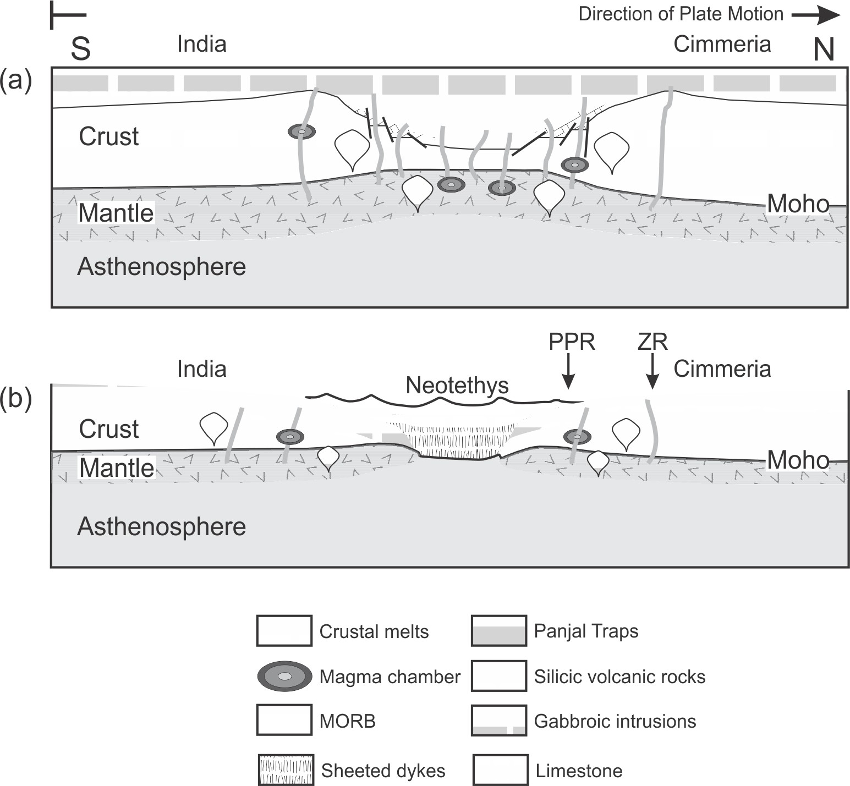
Fig. 12. Tectonic synthesis of the Panjal Traps. (a) The initial subaerial eruption followed by the (b) subaqueous eruptions and eventual opening of the Neotethys Ocean. The possible pre-India-Eurasia collision locations of the Pir Panjal (PPR) and Zanskar Range (ZR) basalts are shown.
The final continental Traps were capped by marine sediments whereas regions further from the initial volcanic epicenter were likely still under extension as sea-floor spreading began and the first microcontinental blocks of Cimmeria drifted away from mainland Gondwana. The Neotethys Ocean is born and the initial rift completely transitioned from a continental setting into a mid-ocean ridge setting. Cimmerian blocks drifted northwards until they accreted to the southern margin of Eurasia during the Middle Mesozoic (Metcalfe, 2013). It is likely that only the continental portion and the earliest subaqueous Panjal Traps were preserved within the accreted Cimmerian blocks whereas the younger oceanic equivalents were subducted during closure of the Neotethys Ocean.
Click to open/close ReferencesReferences
Ali, J. R., Aitchison, J. C., Chik, S. Y. S., Baxter, A. T. & Bryan, S. E. 2012. Paleomagnetic data support Early Permian age for the Abor volcanics in the lower Siang Valley, NE India: significance for Gondwana break-up models. Journal of Asian Earth Sciences, 50, 105-115.
Baksi, A. K. 2001. Search for a deep-mantle component in mafic lavas using a Nb-Y-Zr plot. Canadian Journal of Earth Sciences, 38, 813-824.
Bhat, M. I. 1984. Abor Volcanic: further evidence for the birth of the Tethys Ocean in the Himalayan segment. Journal of the Geological Society of London, 141, 763-775.
Bhat, M. I. & Zainuddin, S. M. 1978. Environment of eruption of the Panjal Traps. Himalayan Geology, 8, 727-738
Bhat, M. I. & Zainuddin, S. M. 1979. Origin and evolution of the Panjal volcanics. Himalayan Geology, 9, 421-461.
Bhat, M. I., Zainuddin, S. M. & Rais, A. 1981. Panjal Trap chemistry and the birth of Tethys. Geological Magazine, 118, 367-375.
Campbell, I. H. 2002. Implication of Nb/U, Th/U and Sm/Nd in plume magmas for the relationship between continental and oceanic crust formation and the development of the depleted mantle. Geochimica et Cosmochimica Acta, 66, 1651-1661.
Chauvet, F., Lapierre, K., Bosch, D., Guillot, S., Mascle, G., Vannay, J.-C., Cotton, J., Brunet, P. & Keller Z. F. 2008. Geochemistry of the Panjal Traps basalts (NW Himalaya): records of the Pangea Permian break-up. Bulletin de la Société Géologique de France, 179, 383-395.
Chauvet, F., Dumont, T. & Basile, C. 2009. Structures and timing of Permian rifting in the central Oman Mountains (Saih Hatat). Tectonophysics, 475, 563-574.
Ernst, R.E. 2014. Large Igneous Provinces. Cambridge University Press, 653 p.
Ernst, R. E. & Buchan, K. L. 2001. Large mafic magmatic events through time and links to mantle plume-heads. In: Ernst, R. E. & Buchan, K. L. (eds) Mantle Plumes: Their Identification Through Time, Geological Society of America Special Paper, 352, 483-57.
Fitton, J. G., Saunders, A. D., Norry, M. J., Hardarson, B. S., Taylor, R.N. 1997. Thermal and chemical structure of the Iceland plume. Earth and Planetary Science Letters, 153, 197-208.
Gaetani, M., Garzanti, E. & Tintori, A. 1990. Permo-Carboniferous stratigraphy in SE Zanskar and NW Lahul (NW Himalaya, India). Eclogae Geologicae Helvetiae, 83, 143-161.
Ganju, P. N. 1944. The Panjal Traps: acid and basic volcanic rocks. Proceedings of the Indian Academy of Sciences, 18, 125-131.
Garzanti, E., Angiolini, L. & Sciunnach, D. 1996a. The mid-Carboniferous to lowermost Permian succession of Spiti (Po Group and Ganmachidam Formations; Tethys Himalaya, northern India): Gondwana glaciation and rifting of Neo-Tethys. Geodinamica Acta, 9, 78-100.
Garzanti, E., Angiolini, L. & Sciunnach, D. 1996b. The Permian Kulung Group (Spiti, Lahaul and Zanskar; NW Himalaya): sedimentary evolution during rift/drift transition and initial opening of Neo-Tethys. Rivisita Italiana di Paleontologia e Stratigrafia, 102, 175-200.
Garzanti, E., Le Fort, P. & Sciunnach, D. 1999. First report of Lower Permian basalts in south Tibet: tholeiitic magmatism during break-up and incipient opening of Neotethys. Journal of Asian Earth Sciences, 17, 533-546.
Honegger, K., Dietrich, V., Frank, W., Gansser, A., Thoni, M. & Trommsdorff, V. 1982. Magmatism and metamorphism in the Ladakh Himalayas (the Indus-Tsangpo suture zone). Earth and Planetary Science Letters, 60, 253-292.
Kapoor, H. M. 1977. Pastannah section of Kashmir with special reference to ‘Ophicreas’ bed of Middlemiss. Journal of the Palaeontological Society of India, 20, 339-347.
Lightfoot, P. C., Hawkesworth, C. J., Hergt, J., Naldrett, A. J., Gorbachev, N. S., Fedorenko, V. A., & Doherty, W. 1993. Remobilisation of the continental lithosphere by a mantle plume: major-, trace-element, and Sr-, Nd-, and Pb-isotope evidence from picritic and tholeiitic laves of the Noril’sk district. Contributions to Mineralogy and Petrology, 114, 171-188.
Mallmann, G. & O'Neill, H. St. C. 2009. Mantle melting as a function of oxygen fugacity compared with some other elements (Al, P, Ca, Sc, Ti, Cr, Fe, Ga, Y, Zr and Nb). Journal of Petrology, 50, 1765-1794.
Metcalfe, I. 2013. Gondwana dispersion and Asian accretion: tectonic and palaeogeographic evolution of eastern Tethys. Journal of Asian Earth Sciences, 66, 1-33.
Middlemiss, C. S. 1910. Revision of Silurian-Trias Sequence in Kashmir. Records of the Geological Survey of India, 40, 206-260.
Miyashiro, A. 1974. Volcanic rock series in island arcs and active continental margins. American Journal of Science, 274, 321-355.
Nakazawa, K. & Kapoor, H. M. 1973. Spilitic pillow lava in Panjal Trap of Kashmir, India. Memoirs of the Faculty of Science, Kyoto University. Series of Geology and Mineralogy, 39, 83-98.
Nakazawa, K., Kapoor, H. M., Ishii, K.-I., Bando, Y. Okimura, Y., Tokuoka, T., Murata, M., Nakamura, K., Nogami, Y. Sakagami, S. & Shimizu, D. 1975. The upper Permian and the lower Triassic in Kashmir, India. Memoirs of the Faculty of Science, Kyoto University. Series of Geology and Mineralogy, 42, 1-106.
Papritz, K. & Rey, R. 1989. Evidence for the occurrence of Permian Panjal Trap basalts in the lesser- and higher Himalayas of the western syntaxis area, NE Pakistan. Eclogae Geologicae Helvetiae, 82, 603-627.
Pareek, H. S. 1976. On studies of the agglomerate slate and Panjal Trap in the Jhelum, Liddar, and Sind Valleys, Kashmir. Records of the Geological Survey of India, 107, 12-37.
Pearce, T. H., Gorman, B. E. & Birkett, T. C. 1977. The relationship between major element chemistry and tectonic environment of basic and intermediate volcanic rocks. Earth and Planetary Science Letters, 36, 121-132.
Pogue, K. R., DiPeitro, J. A., Khan, S. R., Hughes, S. S., Dilles, J. H., Lawrence, R. D. 1992. Late Paleozoic rifting in northern Pakistan. Tectonics, 11, 871-883.
Rao, D. R. & Rai, H. 2007. Permian komatiites and associated basalts from the marine sediments of Chhongtash Formation, southeast Karakoram, Ladakh, India. Mineralogy and Petrology, 91, 171-189.
Rudnick, R. L. & Gao, S. 2003. Composition of the continental crust. In: Rudnick, R. L. (ed) The Crust. Treatise on Geochemistry, 3, 1-64.
Sengor, A. M. C. 1987. Tectonics of the Tethysides: orogenic collage development in a collisional setting. Annual Review in Earth and Planetary Sciences, 15, 213-244.
Shellnutt, J. G., Bhat, G. M., Brookfield, M. E. & Jahn, B.-M. 2011. No link between the Panjal Traps (Kashmir) and the Late Permian mass extinctions. Geophysical Research Letters, 38, L19308, doi: 10.1029/2011GL049032.
Shellnutt, J. G., Bhat, G. M., Wang, K.-L., Brookfield, M. E., Dostal, J. & Jahn, B.-M. 2012. Origin of the silicic volcanic rocks of the Early Permian Panjal Traps, Kashmir, India. Chemical Geology, 334, 154-170.
Shellnutt, J. G., Bhat, G. M., Wang, K.-L., Brookfield, M. E., Jahn, B.-M. & Dostal, J. 2014. Petrogenesis of the flood basalts from the Early Permian Panjal Traps, Kashmir, India: geochemical evidence for shallow melting of the mantle. Lithos, 204, 159-171.
Shellnutt, J. G., Bhat, G. M., Wang, K.-L., Yeh, M.-W., Brookfield, M. E. & Jahn, B.-M. 2015. Multiple mantle sources of the early Permian Panjal Traps, Kashmir, India. American Journal of Science, 315, 589-619.
Spencer, D. A., Tonarini, S. & Pognante, U. 1995. Geochemical and Sr-Nd isotopic characterization of Higher Himalayan ecologites (and associated metabasites). European Journal of Mineralogy, 7, 89-102.
Spring, L., Bussy, F., Vannay, J. C., Hunon, S. & Cosca, M. A. 1993. Early Permian granitic dykes of alkaline affinity in the Indian High Himalaya of upper Lahul and SE Zanskar: geochemical characterization and geotectonic implications. In: Trelor, P. J. & Searle, M. (eds) Himalayan Tectonics. Geological Society of London Special Publications, 74, 251-264.
Stojanovic, D., Aitchison, J. C., Ali, J. R., Ahmad, T. & Dar, R. A. 2016. Paleomagnetic investigation of the Early Permian Panjal Traps of NW India: regional tectonic implications. Journal of Asian Earth Sciences, 115, 114-123.
Sun, S.-s. & McDonough, W. F. 1989. Chemical and isotopic systematics of oceanic basalts: implications for mantle composition and processes. In: Saunders, A. D. & Norry, M. J. (eds) Magmatism in the Ocean Basins. Geological Society of London Special Publication, 42, 313-435.
Vannay, J. C. & Spring L. 1993. Geochemistry of the continental basalts within the Tethyan Himalaya of Lahul-Spiti and SE Zanskar, northwest India. In: Trelor, P. J. & Searle, M. (eds) Himalayan Tectonics. Geological Society of London Special Publications, 74, 237-249.
Wang, M., Li, C., Wu, Y.-W. & Xie, C.-M. 2014. Geochronology, geochemistry, Hf isotopic compositions and formation mechanism of radial mafic dykes in northern Tibet. International Geology Review, 56, 187-205.
Wilson, M. 1989. Igneous Petrogenesis. Unwin Hyman London, 466 pp.
Winchester, J. A. & Floyd, P. A. 1977. Geochemical discrimination of different magma series and their differentiation products using immobile elements. Chemical Geology, 20, 325-343.
Wopfner, H. & Jin, X. C. 2009. Pangea megasequences of Tethyan Gondwana-margin reflect global changes of climate and tectonism in Late Palæozoic and Early Triassic times – a review. Palaeoworld, 18, 169-192.
Workman, R. K. & Hart, S. R. 2005. Major and trace element composition of the depleted MORB mantle (DMM). Earth and Planetary Science Letters, 231, 53-72.
Workman, R. K., Hart, S. R., Jackson, M., Regelous, M., Blusztajn, J., Kurz, M. & Staudigel, H. 2004. Recycled metasomatized lithosphere as the origin of the enriched mantle II (EM2) end-member: evidence from the Samoan volcanic chain. Geochemistry, Geophysics, Geosystems, 5, Q04008, doi:10.1029/2003GC000623.
Xu, W., Dong, Y., Zhang, X., Deng, M. & Zheng, L. 2016. Petrogenesis of high-Ti mafic dykes from southern Qiangtang, Tibet: implications for a ca. 290 Ma large igneous province related to the early Permian rifting of Gondwana. Gondwana Research, 36, 410-422.
Yan, Q., Wang, Z., Liu, S., Li, Q., Zhang, H., Wang, T., Liu, D., Shi, Y., Jian, P., Wang, J., Zhang, D. & Zhai, J. 2005. Opening of the Tethys in southwest China and its significance to the breakup of East Gondwanaland in the late Paleozoic: evidence from SHRIMP U-Pb zircon analyses for the Garze ophiolite. Chinese Science Bulletin, 50, 256-264.
Yeh, M.-W. & Shellnutt, J. G. 2016. The initial break-up of Pangæa elicited by Late Palæozoic deglaciation. Scientific Reports, 6, doi: 31442, http://dx.doi.org/10.1038/srep31442.
Zhai, Q.-G., Jahn, B.-M., Su, L., Ernst, R. E., Wang, K.-L., Zhang, R.-Y., Wang, J. & Tang, S. 2013. SHRIMP zircon U-Pb geochronology, geochemistry and Sr-Nd-Hf isotopic compositions of a mafic dyke swarm in the Qiangtang terrane, northern Tibet and geodynamic implications. Lithos, 174, 28-43.
Zindler, A. & Hart, S. R. 1986. Chemical geodynamics. Annual Review of Earth and Planetary Sciences, 14, 493-571.
Zhu, D.-C., Mo, X.-X., Zhao, Z.-D., Niu, Y., Wang, L.-Q., Chu, Q.-H., Pan, G.-T., Xu, J.-F. & Zhou, C.-Y. 2010. Presence of Permian extension- and arc-type magmatism in southern Tibet: paleogeographic implications. Geological Society of America Bulletin, 122, 979-993.
